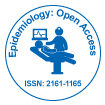మా గ్రూప్ ప్రతి సంవత్సరం USA, యూరప్ & ఆసియా అంతటా 3000+ గ్లోబల్ కాన్ఫరెన్స్ ఈవెంట్లను నిర్వహిస్తుంది మరియు 1000 కంటే ఎక్కువ సైంటిఫిక్ సొసైటీల మద్దతుతో 700+ ఓపెన్ యాక్సెస్ జర్నల్లను ప్రచురిస్తుంది , ఇందులో 50000 మంది ప్రముఖ వ్యక్తులు, ప్రఖ్యాత శాస్త్రవేత్తలు ఎడిటోరియల్ బోర్డ్ సభ్యులుగా ఉన్నారు.
ఎక్కువ మంది పాఠకులు మరియు అనులేఖనాలను పొందే ఓపెన్ యాక్సెస్ జర్నల్స్
700 జర్నల్స్ మరియు 15,000,000 రీడర్లు ప్రతి జర్నల్ 25,000+ రీడర్లను పొందుతున్నారు
ఇండెక్స్ చేయబడింది
- ఇండెక్స్ కోపర్నికస్
- గూగుల్ స్కాలర్
- షెర్పా రోమియో
- జెనామిక్స్ జర్నల్సీక్
- సేఫ్టీలిట్
- వ్యవసాయంలో గ్లోబల్ ఆన్లైన్ పరిశోధనకు యాక్సెస్ (AGORA)
- సెంటర్ ఫర్ అగ్రికల్చర్ అండ్ బయోసైన్సెస్ ఇంటర్నేషనల్ (CABI)
- RefSeek
- హమ్దార్డ్ విశ్వవిద్యాలయం
- EBSCO AZ
- OCLC- వరల్డ్ క్యాట్
- CABI పూర్తి వచనం
- క్యాబ్ డైరెక్ట్
- పబ్లోన్స్
- జెనీవా ఫౌండేషన్ ఫర్ మెడికల్ ఎడ్యుకేషన్ అండ్ రీసెర్చ్
- యూరో పబ్
- ICMJE
ఉపయోగకరమైన లింకులు
యాక్సెస్ జర్నల్స్ తెరవండి
ఈ పేజీని భాగస్వామ్యం చేయండి
నైరూప్య
The Rural Aged and their Health: A Poverty-Health Viewpoint
Paul Andrew Bourne, Ikhalfani Solan, Charlene Sharpe-Pryce, Jannine Campbell-Smith and Cynthia Francis
Introduction: In Jamaica, rural poverty is twice that of urban poverty with about 50 percentage points of elderly residing in rural zones. Poverty is not only a measure of the economic reality; it is also a critical driver of the health challenge being experienced by this vulnerable group.
Objectives: The present study aims to 1) evaluate health of rural elderly, 2) determine factors that influence selfrated health status of the rural aged, 3) determine factors of self-reported illness among rural aged in Jamaica, and 4) examine the changing patterns of diseases of the rural aged Jamaicans over a 5-year period.
Methods: This paper utilizes a cross sectional probability survey design from the Jamaica Survey of Living Conditions (JSLC) dataset. JSLC is a modification of the World Bank Living Standard Survey. Two of the JSLC were used for this research, 2002 and 2007. This research extracted rural aged (60+ year olds) from each year, 2,010 and 404 respectively. Descriptive statistics provide pertinent information on the socio-demographics characteristics of the sampled respondents. Logistic regressions were used to established health models, and a p value <5% was used to determine statistical significance.
Findings: In 2002, 23.2% of rural elderly were below the poverty line. This rose by 6.5% in 2007; wherein at least 66% sought medical care; 27.3% had poor self-rated health status, and self-reported illness was 39.4% in 2002 and this rose by 14.0% in 2007 over 2002. Of those who reported an illness, 75.4% had chronic conditions with 44.0% had hypertension.
Conclusion: The findings which emerged from
సబ్జెక్ట్ వారీగా జర్నల్స్
- ఆహారం & పోషకాహారం
- ఇంజనీరింగ్
- ఇన్ఫర్మేటిక్స్
- ఇమ్యునాలజీ & మైక్రోబయాలజీ
- ఎకనామిక్స్ & అకౌంటింగ్
- కంప్యూటర్ సైన్స్
- కెమికల్ ఇంజనీరింగ్
- క్లినికల్ సైన్సెస్
- గణితం
- జనరల్ సైన్స్
- జియాలజీ & ఎర్త్ సైన్స్
- జెనెటిక్స్ & మాలిక్యులర్ బయాలజీ
- నర్సింగ్ & హెల్త్ కేర్
- పర్యావరణ శాస్త్రాలు
- ఫార్మాస్యూటికల్ సైన్సెస్
- బయోకెమిస్ట్రీ
- బయోమెడికల్ సైన్సెస్
- భౌతిక శాస్త్రం
- మెటీరియల్స్ సైన్స్
- మెడికల్ సైన్సెస్
- రసాయన శాస్త్రం
- వెటర్నరీ సైన్సెస్
- వ్యాపార నిర్వహణ
- సామాజిక & రాజకీయ శాస్త్రాలు
క్లినికల్ & మెడికల్ జర్నల్స్
- అంటు వ్యాధులు
- అణు జీవశాస్త్రం
- అనస్థీషియాలజీ
- ఆరోగ్య సంరక్షణ
- ఆర్థోపెడిక్స్
- కార్డియాలజీ
- క్లినికల్ రీసెర్చ్
- గ్యాస్ట్రోఎంటరాలజీ
- జన్యుశాస్త్రం
- టాక్సికాలజీ
- డెంటిస్ట్రీ
- డెర్మటాలజీ
- నర్సింగ్
- నెఫ్రాలజీ
- నేత్ర వైద్యం
- నేత్ర వైద్యం
- న్యూరాలజీ
- పల్మోనాలజీ
- పీడియాట్రిక్స్
- పునరుత్పత్తి ఔషధం
- ఫిజికల్ థెరపీ & పునరావాసం
- మందు
- మధుమేహం & ఎండోక్రినాలజీ
- మనోరోగచికిత్స
- మైక్రోబయాలజీ
- రేడియాలజీ
- రోగనిరోధక శాస్త్రం
- సర్జరీ
- హెమటాలజీ

 English
English  Spanish
Spanish  Chinese
Chinese  Russian
Russian  German
German  French
French  Japanese
Japanese  Portuguese
Portuguese  Hindi
Hindi